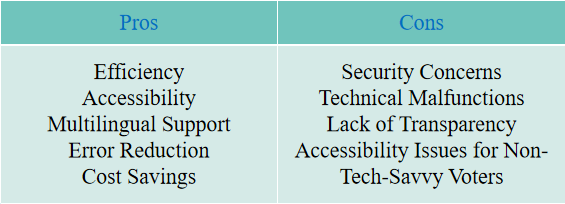Pros And Cons Of Electronic Voting Machines
Depending on the particular implementation, e-voting may use standalone electronic voting machines (EVM) or computers connected to the Internet (online voting). Electronic voting machines have become a prevalent tool in modern elections, aiming to enhance efficiency and accuracy in the voting process. However, as with any technology, there are both advantages and disadvantages associated with their implementation. This article will explore the pros and cons of electronic voting machines to provide a comprehensive understanding of their impact on the electoral process.
*What are the advantages and disadvantages of electronic voting machines?

Merits of electronic voting machines
1. Efficiency:One significant advantage of electronic voting machines is the increased efficiency they bring to the voting process. By automating the vote counting procedure, these machines can significantly reduce the time required for results to be tabulated accurately. This efficiency allows for quicker dissemination of election outcomes and facilitates the democratic process.
2.Accessibility:Electronic voting machines offer improved accessibility for individuals with disabilities. Through the integration of audio or tactile interfaces, visually impaired or physically challenged voters can independently cast their ballots, ensuring their equal participation in the electoral process. This inclusivity is a significant step towards a more representative democracy.
3.Multilingual Support:In multicultural societies, electronic voting machines can provide multilingual options, allowing voters to navigate the interface and cast their votes in their preferred language. This feature helps bridge language barriers and ensures that language differences do not hinder citizens from exercising their voting rights. It promotes inclusivity and encourages greater civic engagement.
4.Error Reduction:Current electronic voting machines with voter-verified paper audit trails are secure voting methods. History proves the reliability of electronic voting machines. Electronic voting machines minimize the possibility of human errors that may occur during manual counting or interpretation of paper ballots. The automated recording and tabulation of votes eliminate ambiguity and reduce the likelihood of discrepancies. This accuracy enhances public trust in the electoral system and strengthens the legitimacy of election results.

5.Cost Savings:Voters save time and cost by being able to vote independently from their location. This may increase overall voter turnout. The citizen groups benefiting most from electronic elections are the ones living abroad, citizens living in rural areas far away from polling stations and the disabled with mobility impairments. While the initial investment in electronic voting machines may be substantial, they can lead to long-term cost savings. The elimination of paper-based systems reduces the need for extensive printing and storage of physical ballots. Over time, electronic voting machines can prove more cost-effective, especially in recurring elections.
Demerits of electronic voting machines
1. Security Concerns:One of the primary concerns surrounding electronic voting machines is their vulnerability to hacking, tampering, or manipulation. Malicious actors could potentially exploit weaknesses in the system, compromising the integrity of the electoral process. Ensuring robust cybersecurity measures and regularly updating the machines' software is crucial to mitigate these risks and maintain trust in the system. However, voters’ confidence in the security, accuracy, and fairness of voting machines is low. A 2018 national survey found about 80% of Americans believed the current voting system may be vulnerable to hackers.(https://votingmachines.procon.org/)
2. Technical Malfunctions:Another drawback of electronic voting machines is the possibility of technical malfunctions or system failures. Glitches in the software, hardware errors, or power outages can disrupt the voting process and lead to delays or loss of data. Adequate testing, maintenance, and backup systems are necessary to minimize such issues and ensure smooth operations during elections.


3. Lack of Transparency:The use of electronic voting machines may raise concerns about the transparency of the voting process. Unlike traditional paper ballots that can be physically observed and recounted, electronic systems rely on digital records that are not easily accessible or verifiable by the public. To address this, implementing measures such as conducting regular audits and providing transparency in the system's design and operation can help enhance trust in electronic voting.
4. Accessibility Issues for Non-Tech-Savvy Voters:While electronic voting machines aim to improve accessibility, they can pose challenges for voters who are not familiar with technology. Elderly or less tech-savvy individuals may find it difficult to navigate the machine's interface, potentially leading to confusion or errors in casting their votes. Offering comprehensive voter education programs and providing assistance at polling stations can address these accessibility concerns.
Overall, implementing stringent security measures, conducting regular audits, and providing adequate voter education are essential in building public trust and confidence in electronic voting systems. By carefully weighing the pros and cons, policymakers can make informed decisions regarding the implementation and enhancement of electronic voting machines for fair and reliable elections.
Post time: 03-07-23




